BASIC WAHNAM TAIJIQUAN COMBAT SEQUENCES
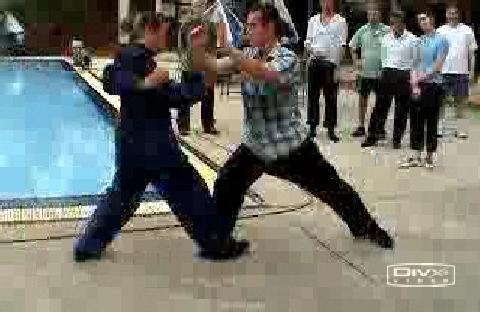
Sifu Wong and Sifu Robin demonstrating Taijiquan combat application form the Basic Combat Sequences
Taijiquan is an internal martial art. By definition, it means that not only is Taijiquan effective for fighting but also that its practitioners use internal force in combat. Hence, Taijiquan practitioners by using internal force can be relaxed yet very powerful while fighting, and they can be fighting for some time without feeling tired or panting for breath.
When many Taiji practitioners today do not even know the combat application of the forms they perform in solo practice, it is understandable that many may find it hard to believe this is possible. But to deride that internal force is fake or that Taijiquan cannot be used for combat is insulting to generations of Taijiquan masters before us, whose manifestations of internal force such as being graceful yet very powerful even at old age and whose combat efficiency using typical Taijiquan patterns are recorded in Taijiquan literature still extant today.
Participants at the Taijiquan Review Course of December 2006 reviewed the practice of Wahnam Taijiquan as an internal martial art. The internal force aspect was reviewed through exercises like stance training and energy flow. The martial aspect was reviewed through the Twelve Basic Combat Sequences of our Wahnam Taijiquan as shown in this video series.
As these combat sequences are pre-arranged, it is often asked whether by practicing them one can be efficient in free sparring or real fighting. No, practicing combat sequences by itself is insufficient to be combat efficient. This is a main reason why those who just practice combination sets (commonly called two-men sets), which are sets of pre-arranged combat sequences linked together, cannot apply their kungfu forms for free sparring or real fighting.
Practicing pre-arranged combat sequences is only one of the numerous steps between solo form training and free sparring, but it is a very important step. When one is familiar with the pre-arranged sequences, he proceeds to progressive steps where the fully controlled pre-arranged movements are systematically released until eventually he can free spar spontaneously. In our school, such progressive steps include what we call “continuation”, “modification”, “surprise counters”, “external changes”, and “internal changes”. Or collectively they can be summed up as “subtraction and addition”.
More important than the techniques in the combat sequences are relevant combat skills. The three fundamental skills, which should be mastered even at the solo form level, are form, force and speed. The forms should be picture-perfect, and there should be reasonable force and appropriate speed. Fundamental combat skills at the combat application level are right spacing, right timing, footwork adjustment, instant change and fluidity of movement.
A special feature in our school is fun, even during combat training, which is something many martial artists of other schools find hard to comprehend. Thus, you will hear much laughter in the video clips.
The 12 Basic Wahnam Taijiquan Combat Sequences
- Immortal Waves Sleeves
- Low Stance Vertical Punch
- White Snake Shoots Venom
- Green Dragon Shoots Pearl
- White Crane Flaps Wings
- Striking Tiger Poise
- Thrust Kick
- Low Stance Single Whip
- Black Bear Sinks Hips
- Shoulder Strike
- Cloud Hands
- Carry Tiger Back to Mountain
Sequence 1: Immortal Waves Sleeves
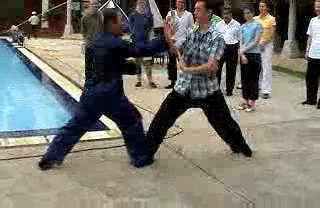
Surprising it may be, many Taijiquan practitioners do not realize that body-work, or “shen-fa”, is very important in Taijiquan. It is emphasized right at this first combat sequence. Notice that the both the initiator and the responder make use of body-work, without moving their feet, in attack and defence.
A picture series showing the sequence and its philosophy can be found here.
Sequence 2: Low Stance Verical Punch
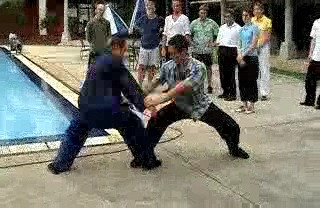
The initiator uses “one to tame two” and simultaneously executes “Punch Below Sleeves”, often striking an opponent without the latter knowing where the attack comes from. The responder sinks his stance to avoid the strike and grips the attacker's both hands. The initiator applies a skillful combination of circular hands and push, which releases the grip and attacks the opponent.
A picture series showing the sequence and its philosophy can be found here.
Sequence 3: White Snake Shoots Venom
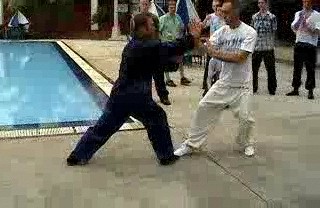
The initiator attacks with “White Snake Shoots Venom” three times, but each time it is different. The first time is a straight attack, the second time he “opens” the responder's defence, and the third time he “closes” the defence. Hence, this sequence illustrates that the same pattern may be used in different ways.
A picture series showing the sequence and its philosophy can be found here.
Sequence 4: Green Dragon Shoots Pearl
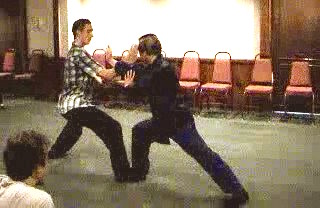
“Green Dragon Shoots Pearl” is a versatile pattern making good use of all the three external harmonies, namely the harmonies of hands, body and legs. In other words, the hand movement should be coordinated with good body-work and foot-work. This sequence is useful in training foot-work adjustment.
A picture series showing the sequence and its philosophy can be found here.
Sequence 5: White Crane Flaps Wings
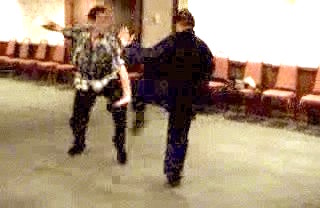
Sequence 5 introduces kicking attacks. Here the deadly “organ-seeking kick” is used, implemented by the pattern “White Crane Flaps Wings”. Interestingly, the counter is also “White Crane Flaps Wings”, introducing the tactic of “no-defence-direct-counter”, striking the kicking leg as the attack is just spent.
A picture series showing the sequence and its philosophy can be found here.
Sequence 6: Striking Tiger Poise
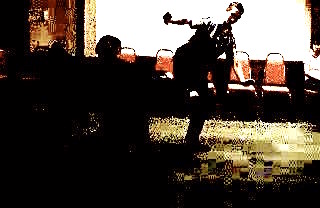
“Striking Tiger Poise” can be applied to counter against any kicks! Here it is used to avoid a side-kick.
A picture series showing the sequence and its philosophy can be found here.
Sequence 7: Thrust Kick
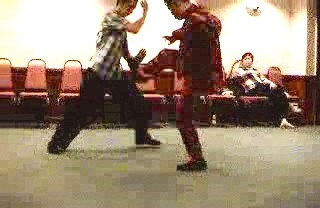
This sequence uses the tactic of “continuous attacks”, opening with two hand attacks and concluding with a thrust kick. If you are skillful, by repeating this sequence again and again, you may make your opponent quite helpless.
A picture series showing the sequence and its philosophy can be found here.
Sequence 8: Low Stance Single Whip
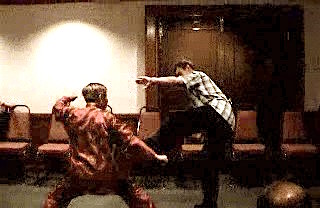
In this sequence the responder counters with two continuous kicking attacks, namely a side-kick and a sweeping kick. Like “Striking Tiger Poise”, “Low Stance Single Whip” can be used against any kicks!
A picture series showing the sequence and its philosophy can be found here.
Sequence 9: Black Bear Sinks Hips
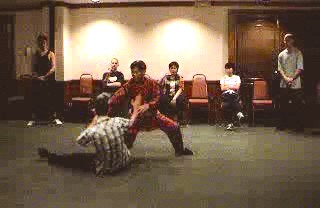
This sequence introduces felling attacks. “Black Bear Sinks Hips” is a marvelous counter, felling an opponent at a time when he thinks he fells you! This technique is also an excellent demonstration of Taijiquan skills and principles.
A picture series showing the sequence and its philosophy can be found here.
Sequence 10: Shoulder Strike
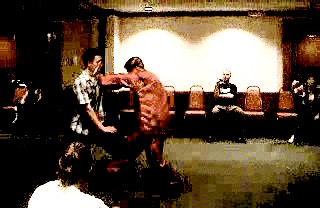
What would you do if an opponent grips your arm and pulls you forward. Instead of resisting, go along with his pull and counter with a shoulder strike. This excellently illustrates the Taijiquan principle of using the opponent momentum against himself.
A picture series showing the sequence and its philosophy can be found here.
Sequence 11: Cloud Hands
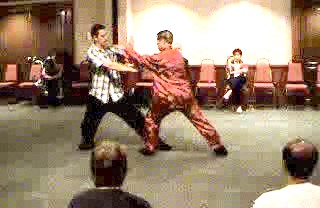
This “Cloud Hands” technique in this sequence illustrates a skillful combination of footwork, body-work and hand-movement to counter an opponent's double grips on your arm.
A picture series showing the sequence and its philosophy can be found here.
Sequence 12: Carry Tiger Back to Mountain
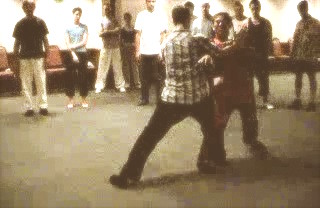
“Carry Tiger Back to Mountain” is a marvelous counter against an opponent gripping you from behind. You fell the opponent at a time when he thinks he has you in full control. An effective counter against this felling attack is “Throw Knee” where appropriate footwork is crucial.
A picture series showing the sequence and its philosophy can be found here.
12 Taijiquan Combat Sequences -- December 2006 from Wong Kiew Kit on Vimeo.
LINKS
Related Pages
- Combat Sequences of Wahnam Taijiquan — Picture Series
- Learning the Twelve Taijiquan Combat Sequences
- Step by Step Learning of the 12 Sequences
Courses and Classes
